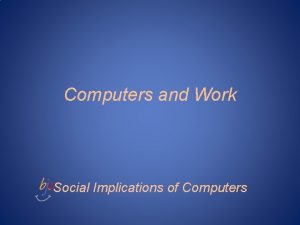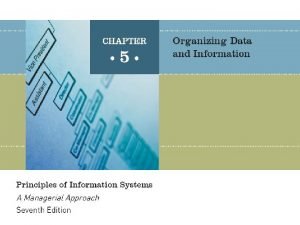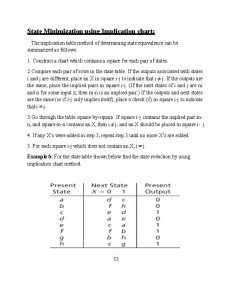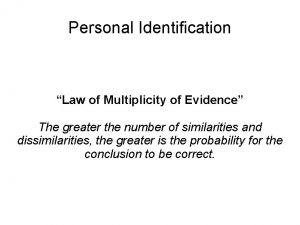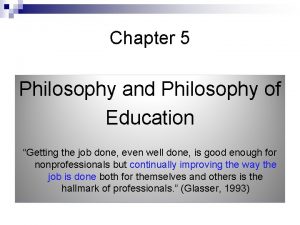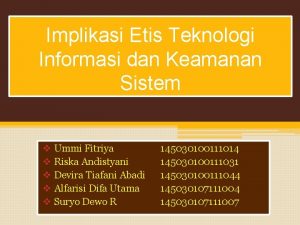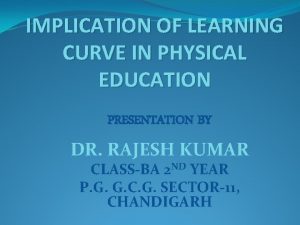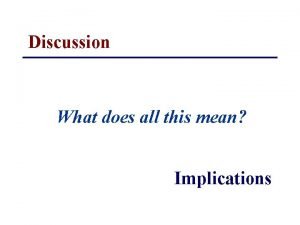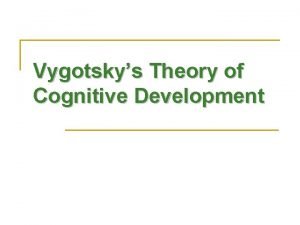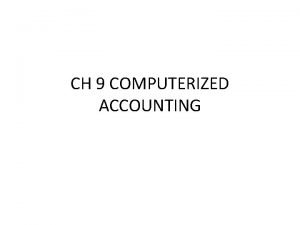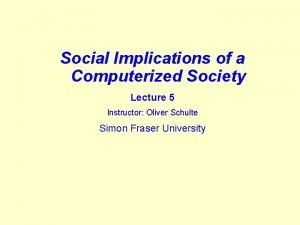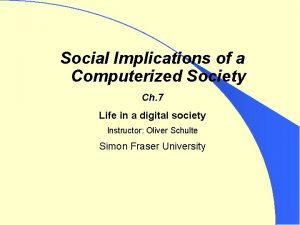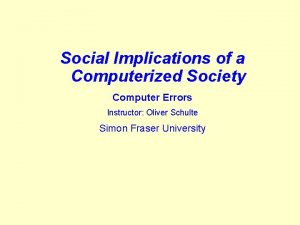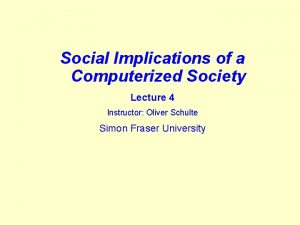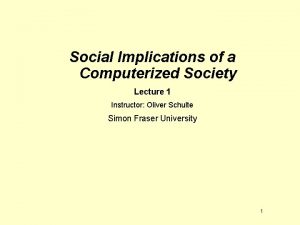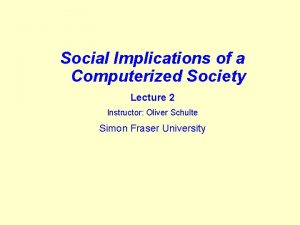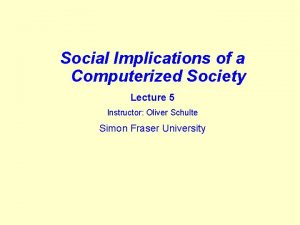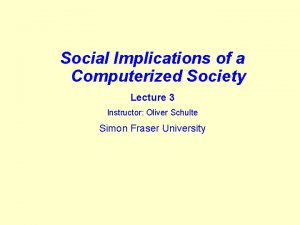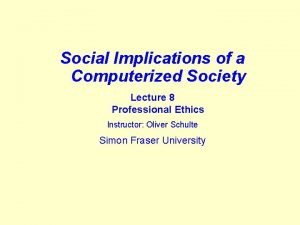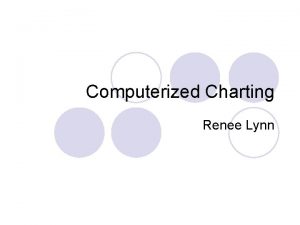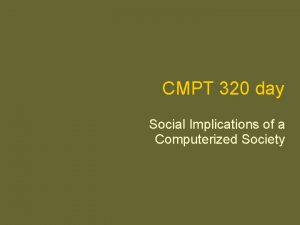Social Implications of a Computerized Society A Crash
















































- Slides: 48

Social Implications of a Computerized Society A Crash Course in Economics Instructor: Oliver Schulte Simon Fraser University

Internet and Market Competition • Some claim (e. g. Bill Gates) that the Internet leads to a “frictionless” market • Few transaction costs, easy to find customers and vendors Ø approximates the ideal competitive market of classic economic theory

The Ideal Competitive Market • perfect information: all agents know all the products and prices. • no barriers to market entry: anyone can start selling a good. • no transaction costs: costs of making and executing the deal (e. g. , shipping) can be neglected.

The Profit Model Market Share Revenue Profit Price Production Costs

The Bertrand Game (1883) • Consider a homogenous good where 2 firms compete only on price. – e. g. , Coldplay’s latest CD. • Fix total demand D. – e. g. , 1000 people want to pay the CD, so D = 1, 000. • Assume same unit cost c for each firm (staff, rent, advertising, materials). – e. g. , each company has costs of $5 for CD. • Options: Each company sets a price for selling the CD.

Bertrand Game Outcomes • Outcomes: Suppose we have price p 1 for firm 1, price p 2 for firm 2. – If p 1 > p 2, all customers in an ideal market will buy from the cheaper company. Ø So the revenue for firm 1 is 0. • e. g. if firm 1 charges $7, firm 2 charges $6, firm 1 makes no sales. • If p 1 = p 2 = p, the firms split the demand, and the revenue for each is (p – c) x D/2. – e. g. if p = $7, the revenue of each company is (7 -5) x 1000/2 = 1000. • What will be the choices of the firms?

Bertrand Game Examples Small-scale example so we can play this out in class Demand Cost 4 $1 Firm 1/Firm 2 $6 $7 $7 firm 1: $0. firm 1: $7 x 2 - $1 x 2 = $12 firm 2: revenue = $7 x 4 cost = $1 x 4 profit = $28 -$4 = $24 firm 2: ditto

Exercises Demand D Cost c 4 $1 • Show that in our Bertrand model, it pays to bid 1 cent less than your competitors price p if and only if p > c + 0. 02. • Show that this holds for any demand D > 0 and any cost c > 0.

Equilibrium Analysis • In the stable state of an ideal competitive market, each company charges just enough to recover their costs. • In the Bertrand model, price = cost • In our example, CD price = $1

Real-World Examples of Falling Costs • Memory: Compared to 1970, the cost per memory bit has gone down by a factor of 1 Bn • Prices for Cellphones have dropped substantially over the last 30 years

Profit Model Market Share Revenue Profit Price Production Costs Processing Costs Input Costs (Labour, Materials, Machines Discussion Question: how can companies generate profit given the price pressure?

Avoiding Competition in Ways That Benefit Society PRODUCTIVITY AND NICHES

Niches • Compete not only on price, but also on brand, trust, service, etc – e. g. Iphone vs. Samsung – Mercedes vs. Ford • Ride-sharing offers transportation in a different way from taxis

Productivity and Innovation • Companies can innovate to become more efficient Ø produce the same good with same price but lower production costs + Productivity = output/input (output per hour of work/operation) • Productive Society = Wealthy Society Production Costs Input Costs (Labour, Materials, Machines Processing Costs

The Invisible Hand of the Competitive Market • “Every individual. . . neither intends to promote the public interest, nor knows how much he is promoting it. . . he intends only his own security; and by directing that industry in such a manner as its produce may be of the greatest value, he intends only his own gain, and he is in this, as in many other cases, led by an invisible hand to promote an end which was no part of his intention. ” • “It is not from the benevolence of the butcher, the brewer, or the baker, that we expect our dinner, but from their regard to their own interest. We address ourselves, not to their humanity but to their self-love, and never talk to them of our necessities but of their advantages. ” Adam Smith 1723 -1790

Avoiding Competition MARKET COLLUSION

Market Entry Barriers for Competitors • Tariffs • Credentials, Licenses, Legal Compliance • High Capital Costs, Economies of Scale (refineries, internet platforms) • People are willing to pay more to buy from the known retailer. – For example, it is estimated that Amazon has a 5% margin advantage over unbranded retailers for first-time visitors.

Collusion • “People of the same trade seldom meet together, even for merriment and diversion, but the conversation ends in a conspiracy against the public, or in some contrivance to raise prices. ” Adam Smith • Real-world example: silicon valley’s antipoaching agreement

Forces against Collusion • Law: strong legal penalties for anticompetitive behaviour • Canada’s Competition Bureau • Difficult to make contracts for illegal collusion –can would-be colluders trust each other?

Trust Among Colluders • Recall the Bertrand Model example. • Suppose only two companies sell the CD and they want to fix the price at $10. • For simplicity, suppose each company has two options – keep their word and sell at $10 – undercut and sell for $9

The Prisoner’s Dilemma in the Competitive Market Demand Cost 4 $1 Firm 1/Firm 2 $10 $9 $10 $18, $18 $32, $0 $9 $0, $32 $16, $16 • Fill in the outcomes for each pair of choices • What is the optimal strategy for each firm?

Mergers • A legal way to collude is for competitors to merge Ø monopolies, loss of competition, higher prices, less productivity • Controlled by government regulations about market concentration

CUTTING INPUT COSTS

Increasing Productivity vs. Cutting Costs Production Costs Processing Costs Input Costs (Labour, Materials, Machines • In Adam Smith’s ideal world, companies cut processing costs through raising productivity • Another option is to cut input costs

Increasing Productivity vs. Cutting Costs Production Costs Processing Costs Input Costs (Labour, Materials, Machines • In Adam Smith’s ideal world, companies cut processing costs through raising productivity • Another option is to cut input costs

Examples • Walmart uses its bargaining power to bring down prices from suppliers • Amazon asks governments for taxbreaks and subsidies • The Canadian lumber industry lobbies the government to charge them lower stumpage fees • The U. S. charges this is an unfair subsidy

MARXIST CRITIQUE

The Structure of Production • Marx: the classical model is appropriate for shipwreck Robinson Crusoe – transforms raw materials from his island into goods of value for himself • But in modern production, many people work together to add value to raw materials. Ø Conflicts about how gets what share of the added value (profit)

The Means (Factors) of Production • • Land (nature, raw materials) Capital (money to buy machines) Labour (to work machines) Capital + Labour work together to add value to Land Product Labour Capital (Machines) Land (Raw Materials)

The Class Struggle • Capital and Labour are in conflict about who gets what share of the added value (profits) Class Struggle • Intensified by the pressure on profits from market competition • Class Struggle is destructive • According to Marx, owners have the upper hand • Wage competition by workers drives down wages to subsistence level (the "Iron Law”)

Demand-Side Economics KEYNESIAN CRITIQUE

Demand-Side Economics • Bertrand’s Model assumes that the demand is fixed and not influenced by the market players. • Demand is exogenous. – Recall Marx’ comparison with Robinson Crusoe • But in the real economy, people can buy goods in the market because they sell goods (services) in the market.

Competition Game Revisited • To simplify, suppose we have only 1 music company (monopoly). • To earn money, 4 music lovers sell blank CDs to the music company. • They use the money from the blank CD sales to buy a new CD. • What happens to the profits of the music company if the music lovers lower the price for the blank CD? – Do profits go up or down?

The Paradox of Thrift • For the whole economy, spending = income. – e. g. GDP = sum of goods and services sold • If everybody saves, we all have less income. • If everybody spends, we all have more income.

Sector Balance Mechanics • It is helpful to analyze spending by 4 big sectors in a national economy. – government – private households – private businesses – foreigners • Spending + Income has to balance out across all 4 sectors. • If all 4 sectors save, all 4 sectors lose income.

Historical Sector Spending in Canada • Traditional Pattern for Net Balances: – private households save (retirement, down payments) – companies spend (go into debt to invest) • In the last 25 years or so, private businesses have been net savers –weird! See also here • Raises the spectre of the paradox of thrift

Keynesian Analysis of Recessions • The big problem in an economy is unemployment • Unemployment happens in recessions = Economy shrinking • In Keynesian view, the cause is demand weakness: too much net saving in the economy • Keynes’ approach: if the private sector is saving too much, the government must go into debt • Gvt spending creates demand grows the economy

The Economy as a Feedback Loop Demand Profits Wages Investment • In a boom: positive feedback loop • In a recession: negative feedback loop • Explains the business cycle (? )

Keynes Quote • “If the Treasury were to fill old bottles with banknotes, bury them at suitable depths in disused coalmines which are then filled up to the surface with town rubbish, and leave it to private enterprise on well-tried principles of laissez-faire to dig the notes up again. . . there need be no more unemployment and, with the help of repercussions, the real income of the community, and its capital wealth, would probably become a good deal greater than it actually is. " • “The boom, not the slump, is the time for austerity”

Historical Examples • Henry Ford on raising wages • Recently Amazon has made a similar move • Roosevelt’s New Deal

Supply Side Economics • The government can move money into the private sector by spending (Keynes) • But also by cutting taxes

The Golden Wage Rule • Most modern governments have an inflation target • The Golden Rule (simplified): Wages should grow by productivity + inflation target. • Wages seem to be lagging productivity in the U. S. , less so in Canada

Technology and Innovation in the Marketplace SCHUMPETER AND INNOVATION

The Importance of Innovation • enterpreneurial innovation productivity lasting wealth • Economic policies should give priority to innovation aka “technology shocks” • Support “creative destruction” (disruption) against the interests of powerful incumbents • Allow technology leaders to benefit from “temporary monopolies” (first-mover advantage). – Better than patents (? ) • Big companies can innovate because they have enough money to develop ideas

Example: The Iphone • Iphone disrupted cell phone market – creatively destroyed Black. Berry • temporary monopoly: could charge more than cell phones in 2007 • competition caught up and brought prices down again

Discussion Question • How would you look at ride-sharing (Uber) from the four different perspectives? What issues would each framework raise? 1. Classic market competition (Smith) 2. Marxist critique 3. Keynesian demand-side economics 4. Schumpeter innovation and enterprise

Summary I • Different schools of economics emphasize different aspects and raise different questions • Classical: emphasizes the benefits of market competition for consumers and productivity • Marxist: emphasizes conflict between owners (capital) and workers (labour) over share of profits (added value) • Keynesian: – holistic view of the economy: total spending = total income – feedback system: demand stimulates growth • Schumpeter:

Summary II • Keynesian: – holistic view of the economy: total spending = total income – feedback system: demand stimulates growth • Schumpeter: emphasizes the importance of innovation for economic growth – entrepreneurs with novel ideas bring “creative destruction” (disruption) and productivity – need access to capital – temporary monopolies protect first-mover profits from market competition
 Legal implications of social media
Legal implications of social media Social implications of computers
Social implications of computers Social psychology crash course
Social psychology crash course Gertler econ
Gertler econ Social thinking and social influence in psychology
Social thinking and social influence in psychology Social thinking social influence social relations
Social thinking social influence social relations Database approach to data management
Database approach to data management Educational implications of constructivism
Educational implications of constructivism Implication table method
Implication table method Nursing implications for synthroid
Nursing implications for synthroid What is structural dissociation
What is structural dissociation How audience negotiate meaning in mil
How audience negotiate meaning in mil Marketing implications
Marketing implications What is tautology in math
What is tautology in math Math
Math Philosophy of education
Philosophy of education Marketing implications
Marketing implications Nursing implications
Nursing implications Albert bandura theory
Albert bandura theory Implications of nativist theory
Implications of nativist theory Implications of nativist theory
Implications of nativist theory Implikasi etis adalah
Implikasi etis adalah Educational implications of learning curve
Educational implications of learning curve Implications of quantum entanglement
Implications of quantum entanglement Legal implications of nursing documentation
Legal implications of nursing documentation Ranexa nursing implications
Ranexa nursing implications Glargine nursing implications
Glargine nursing implications Pavlov theory of learning
Pavlov theory of learning Discussion and implications
Discussion and implications Vygotsky guided participation example
Vygotsky guided participation example Medical implications of developmental biology
Medical implications of developmental biology What are legal implications
What are legal implications Educational implications of existentialism
Educational implications of existentialism Trends and issues in nursing
Trends and issues in nursing Inotropic effect
Inotropic effect Legal implications of nursing documentation
Legal implications of nursing documentation Future implications definition
Future implications definition Benzonatate nursing implications
Benzonatate nursing implications Flucytosine mechanism of action
Flucytosine mechanism of action Computerized patient chart
Computerized patient chart Checklist method
Checklist method Jev government accounting
Jev government accounting Corelap 01
Corelap 01 Computerised accounting system
Computerised accounting system O graphology
O graphology Computerized letter
Computerized letter An endorsement indicating a new owner of a check
An endorsement indicating a new owner of a check Computerized layout techniques
Computerized layout techniques E commerce accounting principles
E commerce accounting principles

